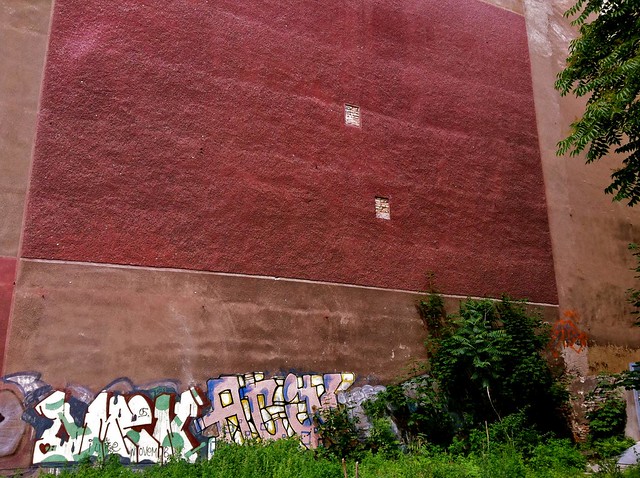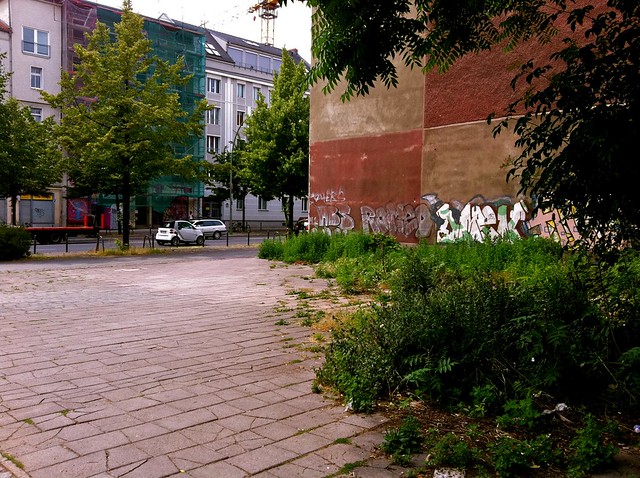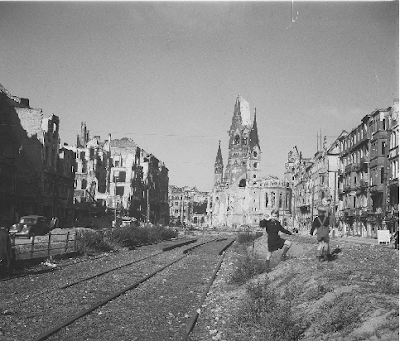All over Berlin there are buildings which end abruptly with huge walls that have no windows or openings - these are referred to as "brandmauers".

Huge blank brandmauer where Anklamer Straße meets Brunnenstraße

Empty lot next to the brandmauer
View Larger Map
Aerial View of street corner (showing the empty lot)
The area of Prenzlauer Berg where I am staying at the moment is described to have remained fairly intact from the bombing, as well as having escaped any significant post-war redevelopment, so it is quite uniformly populated with beautiful old five-storey buildings (largely built in the late 1800s or early 1900s). But even the house we are staying on Senefelderstraße has a brandmauer - there are no windows on one facing of the flat although there is nothing next to it, because there once would have been a building sitting right next to it. Living in such a house, one might say, "a pity, imagine if there could have been windows!" - but of course no one really means to build buildings with entire facings without windows, and the reason for these big flat blind walls and missing buildings in a street is the bombing of Berlin during WWII, which apparently destroyed up to half of all the houses in Berlin between 1943 to 1945.
I found a page that describes why its called Brandmauer rather than Feuerwand (a much more literal translation) - citing that "brennen" is more accurate as it describes a "destructive fire", as opposed to a more benign Lagerfeuer/camp-fire or Kaminfeuer/chimmney-fire; and "mauer" as "masonry" or a stone wall has more of a connotation of "blocking".
[Sidenote 1: A brand can be a feuer, but not all feuers can be brands; Feuer is a more generalised term for Fire]
[Sidenote 2: I suppose the Brandmauer can also be read as the wall that subdivides or separates the buildings to resist the spread of fire, in which case it was indeed successful in keeping all the buildings from destruction]
This only being my first trip to Berlin, one senses that very many years have passed since drastic events that have changed the landscape of the city. At the C-O Berlin I saw an exhibition of Fritz Eschen's black and white photography of post-war Berlin, which documents Berlin's devastated post-war state (the wall text seems to want to emphasise that as a berliner he documents it without pandering to self-pity or sentimentality - no point shedding tears; its all people trying to get on with their lives).
I am always surprised to think of how recent it is. Just a few weeks ago in May I read that the last known surviving WWI veteran (who had also served in both world wars) had finally died, but it brings to my mind that there will still be many older people living today who will have some memory of WWII (and so, how long will it be before the last surviving witness to WWII dies?).
While hopping around trying to take photos of Brandmauers after first being told what they were, I realised for me I am less interested in the images of brandmauer (for they could also mean nothing to foreigners, and there have been so many intervening years since that have altered the city), and I am more interested in the idea that there are people out there who will have known the city before it had buildings destroyed and removed, to leave these gaps. And, people wondering what could have been behind the brandmauer...
View Larger Map


No comments:
Post a Comment